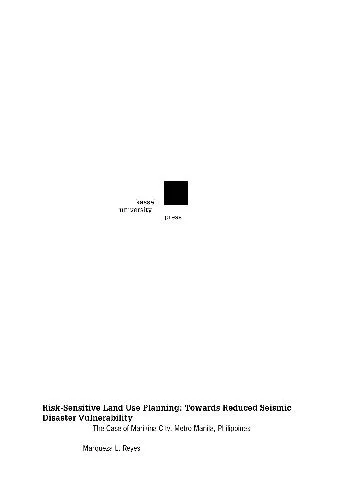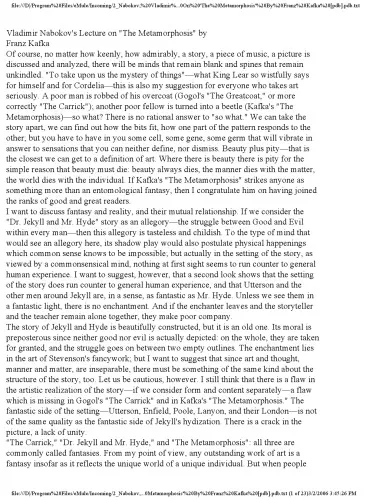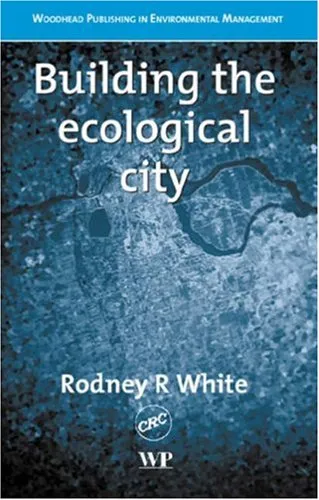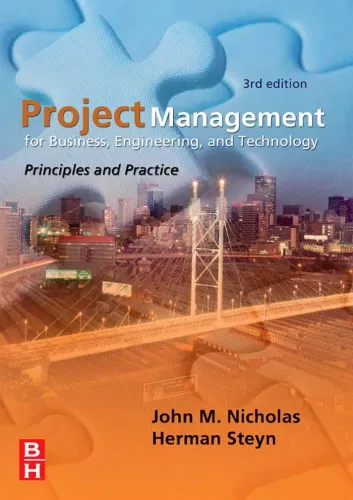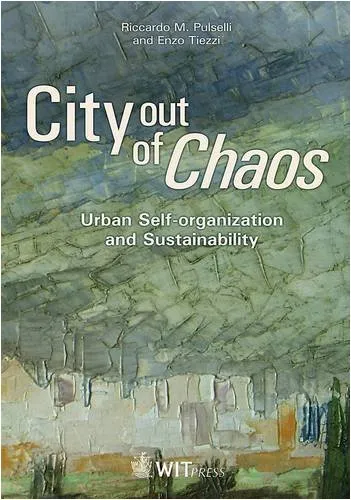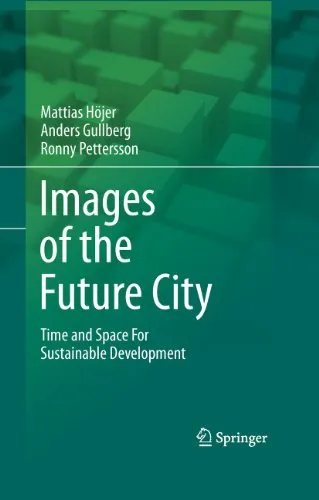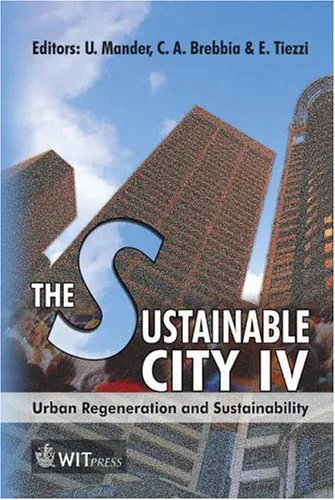Risk-sensitive land use planning towards reduced seismic disaster vulnerability; the case of Marikina City, Metro Manila, Philippines
4.3
بر اساس نظر کاربران

شما میتونید سوالاتتون در باره کتاب رو از هوش مصنوعیش بعد از ورود بپرسید
هر دانلود یا پرسش از هوش مصنوعی 2 امتیاز لازم دارد، برای بدست آوردن امتیاز رایگان، به صفحه ی راهنمای امتیازات سر بزنید و یک سری کار ارزشمند انجام بدینکتاب های مرتبط:
خلاصهای جامع از کتاب
کتاب "Risk-sensitive land use planning towards reduced seismic disaster vulnerability; the case of Marikina City, Metro Manila, Philippines" به تحلیل و بررسی راهکارهای برنامهریزی کاربری زمین با حساسیت به مخاطرات اختصاص دارد که به منظور کاهش آسیبپذیری در برابر زلزله، بهویژه در شهر ماریکینا در منطقه مترو مانیلا، فیلیپین نوشته شده است. ماریکینا به عنوان یکی از شهرهایی که به شدت تحت تأثیر خطرهای ژئولوژیکی قرار دارد، نمونهای ایدهآل برای بررسی و تحلیل این موضوع است. این کتاب تلاش میکند تا از طریق مطالعهای جامع و تطبیق یافته بر اساس شرایط محلی، راهکارهایی برای بهبود و افزایش مقاومت شهر در برابر زلزله ارائه دهد.
نکات کلیدی کتاب
- درک عمیقتری از ارتباط بین کاربری زمین و مخاطرات لرزهای ارائه میدهد.
- ارائه روشهای عملی و سیاستهای مختلف برای کاهش آسیبپذیری لرزهای که قابل اجرا در دیگر شهرهای مشابه نیز هستند.
- بر روی اهمیت دادهها و اطلاعات محیطی در تهیه و اجرای برنامههای کاربری زمین تمرکز میکند.
- توصیههایی برای مقامات محلی و سیاستگذاران در مورد بهرهبرداری از تکنیکهای برنامهریزی زمین برای کاهش خطر زلزله ارائه میدهد.
جملات معروف از کتاب
"برنامهریزی کاربری زمین، اگر به درستی انجام شود، میتواند به عنوان اولین خط دفاعی در برابر بلایای طبیعی عمل کند."
"آسیبپذیری شهرها در برابر زلزله نه تنها به دلیل موقعیت جغرافیایی، بلکه به دلیل نحوه استفاده انسان از زمین است."
چرا این کتاب مهم است
اهمیت این کتاب در توضیح و تبیین یک رویکرد علمی و عملی به مسئلهای چالشبرانگیز و اغلب نادیدهگرفتهشده، یعنی برنامهریزی کاربری زمین با تمرکز بر کاهش خطرات طبیعی، نهفته است. در زمانی که بلایای طبیعی از جمله زلزلهها به دلیل تغییرات اقلیمی و شهرنشینی سریع در حال افزایشاند، این کتاب به عنوان راهنمایی ارزشمند برای شهرسازان، مهندسین محیط زیست، و سیاستگذاران محسوب میشود. با بهرهگیری از دادههای جدید و تحلیلهای تخصصی، این کتاب میتواند شهرها را در برابر زلزلهها مقاومتر و پایدارتر سازد.
Welcome to the detailed introduction to "Risk-sensitive Land Use Planning Towards Reduced Seismic Disaster Vulnerability: The Case of Marikina City, Metro Manila, Philippines." This book emerges at the vital intersection of urban planning, risk management, and seismic vulnerability mitigation.
Detailed Summary
In an era where disasters strike increasingly with devastating effects, understanding how urban planning can mitigate these impacts is crucial. This book dives deep into the landscape of Marikina City, a bustling urban area in Metro Manila known for its vibrant community and, unfortunately, its susceptibility to seismic activities. Marikina City provides an ideal case study for exploring disaster risk reduction due to its location along the West Valley Fault.
The book systematically explores how land use planning, integrated with risk assessment tools, can significantly reduce vulnerability. It outlines the use of Geographic Information Systems (GIS) to analyze the geographical layout against seismic hazards, ensuring that planners can make informed decisions. Additionally, the text examines local governance and community involvement as pivotal elements in crafting and executing these risk-sensitive plans.
Key Takeaways
- Understanding seismic hazards requires a multidimensional approach, combining technology, policy, and community engagement.
- Integrated land use planning can serve as a vehicle for disaster risk reduction.
- The collaboration between local governments and communities is essential for effective implementation.
- Technological tools like GIS can aid in mapping and assessing vulnerabilities, informing more strategic urban planning.
- Policy frameworks must be adaptive to incorporate latest findings and technologies in disaster preparedness.
Famous Quotes from the Book
"Land use planning is not just about the placement of buildings; it is about shaping a resilient future."
"Community involvement isn’t a box to be checked—it’s the backbone of sustainable disaster risk management."
"Risk reduction starts with understanding; understanding begins with data."
Why This Book Matters
This book offers crucial insights into the practice of integrating risk considerations into land use planning, making it relevant to urban planners, policymakers, engineers, and academics worldwide. By focusing on Marikina City, it provides a contextual framework applicable to similar urban areas grapple with seismic vulnerabilities.
In a broader sense, the text serves as a guide for cities globally striving to incorporate resilience in their urban fabric amidst growing threats from natural disasters. It promotes a paradigm shift towards proactive risk management, encouraging cities to not only react to disasters but to anticipate and mitigate them effectively through smart planning.
Furthermore, with climate change exacerbating the frequencies and impacts of natural calamities, the insights gathered from Marikina City’s approach can assist in forming robust responses to environmental challenges, ensuring future urban environments are safe and sustainable.
دانلود رایگان مستقیم
شما میتونید سوالاتتون در باره کتاب رو از هوش مصنوعیش بعد از ورود بپرسید
دسترسی به کتابها از طریق پلتفرمهای قانونی و کتابخانههای عمومی نه تنها از حقوق نویسندگان و ناشران حمایت میکند، بلکه به پایداری فرهنگ کتابخوانی نیز کمک میرساند. پیش از دانلود، لحظهای به بررسی این گزینهها فکر کنید.
این کتاب رو در پلتفرم های دیگه ببینید
WorldCat به شما کمک میکنه تا کتاب ها رو در کتابخانه های سراسر دنیا پیدا کنید
امتیازها، نظرات تخصصی و صحبت ها درباره کتاب را در Goodreads ببینید
کتابهای کمیاب یا دست دوم را در AbeBooks پیدا کنید و بخرید
1522
بازدید4.3
امتیاز0
نظر98%
رضایتنظرات:
4.3
بر اساس 0 نظر کاربران
Questions & Answers
Ask questions about this book or help others by answering
No questions yet. Be the first to ask!
